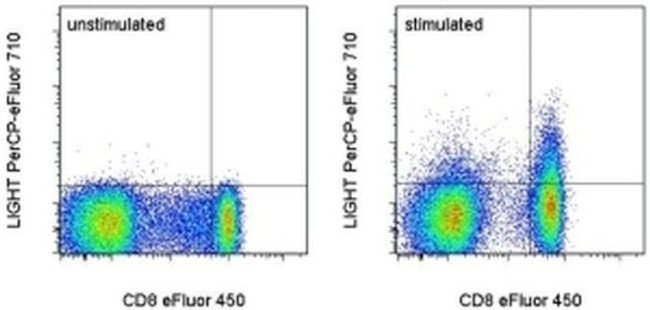Search Thermo Fisher Scientific
Invitrogen
CD258 (LIGHT) Monoclonal Antibody (7-3 (7)), PerCP-eFluor™ 710, eBioscience™
FIGURE: 1 / 1
CD258 (LIGHT) Antibody (46-2589-42) in Flow

Product Details
46-2589-42
Species Reactivity
Host/Isotype
Recommended Isotype Control
Class
Type
Clone
Conjugate
Excitation/Emission Max
Form
Concentration
Purification
Storage buffer
Contains
Storage conditions
Shipping conditions
RRID
Product Specific Information
Description: This 7-3 (7) monoclonal antibody reacts with human CD258 (also known as LIGHT), a 29-kDa type II transmembrane protein that is a member of the TNF ligand superfamily related to lymphotoxin-β (LT-β). Expressed on activated T cells, particularly CD8+ T cells, LIGHT plays a role in cell survival, inflammation, and tumor eradication. Furthermore, upon binding its ligand, herpesvirus entry mediator (HVEM), LIGHT induces a costimulatory effect on T cells, enhancing T cell proliferation and cytokine production. LIGHT has also been shown to indirectly interact with the LT-β receptor.
Applications Reported: This 7-3 (7) antibody has been reported for use in flow cytometric analysis.
Applications Tested: This 7-3 (7) antibody has been pre-titrated and tested by flow cytometric analysis of stimulated normal human peripheral blood cells. This can be used at 5 µL (0.125 µg) per test. A test is defined as the amount (µg) of antibody that will stain a cell sample in a final volume of 100 µL. Cell number should be determined empirically but can range from 10^5 to 10^8 cells/test.
PerCP-eFluor® 710 emits at 710 nm and is excited with the blue laser (488 nm); it can be used in place of PerCP-Cyanine5.5. We recommend using a 710/50 bandpass filter, however, the 695/40 bandpass filter is an acceptable alternative. Please make sure that your instrument is capable of detecting this fluorochrome.
Fixation: Samples can be stored in IC Fixation Buffer (Product # 00-822-49) (100 µL of cell sample + 100 µL of IC Fixation Buffer) or 1-step Fix/Lyse Solution (Product # 00-5333-54) for up to 3 days in the dark at 4°C with minimal impact on brightness and FRET efficiency/compensation. Some generalizations regarding fluorophore performance after fixation can be made, but clone specific performance should be determined empirically.
Excitation: 488 nm; Emission: 710 nm; Laser: Blue Laser.
Filtration: 0.2 µm post-manufacturing filtered.
Target Information
Apoptosis, or programmed cell death, occurs during normal cellular differentiation and development of multicellular organisms. Apoptosis is induced by certain cytokines including TNF (tumor necrosis factor) and Fas ligand of the TNF family through their death domain containing receptors, TNFR1 (tumor necrosis factor receptor 1) and Fas. Cell death signals are transduced by death domain (DD)-containing adapter molecules and members of the ICE (interleukin-1-beta converting enzyme)/CED-3 (C. elegans death receptor-3) protease family. A novel DD-containing molecule was recently cloned from mouse, human and monkey and designated Daxx (death associated protein 6). Daxx binds specifically to the Fas death domain and enhances Fas induced apoptosis and activates the Jun N-terminal kinase (JNK) pathway. Daxx is widely expressed in fetal and adult human and mouse tissues indicating its important function in Fas signaling pathways.
For Research Use Only. Not for use in diagnostic procedures. Not for resale without express authorization.
How to use the Panel Builder
Watch the video to learn how to use the Invitrogen Flow Cytometry Panel Builder to build your next flow cytometry panel in 5 easy steps.
References (0)
Bioinformatics
Protein Aliases: CD258; Herpes virus entry mediator ligand; herpesvirus entry mediator ligand; HVEM-L; sCD258; sLIGHT; soluble CD258; soluble LIGHT; tumor necrosis factor (ligand) superfamily, member 14; tumor necrosis factor ligand 1D; Tumor necrosis factor ligand superfamily member 14
Gene Aliases: CD258; HVEML; LIGHT; LTg; TNFSF14; UNQ391/PRO726
UniProt ID: (Human) O43557
Entrez Gene ID: (Human) 8740

Performance Guarantee
If an Invitrogen™ antibody doesn't perform as described on our website or datasheet,we'll replace the product at no cost to you, or provide you with a credit for a future purchase.*
Learn more
We're here to help
Get expert recommendations for common problems or connect directly with an on staff expert for technical assistance related to applications, equipment and general product use.
Contact tech support

